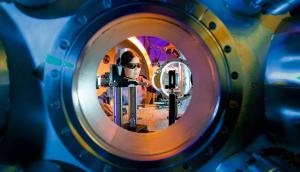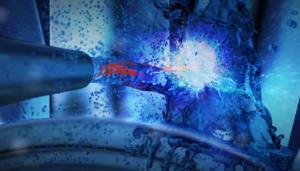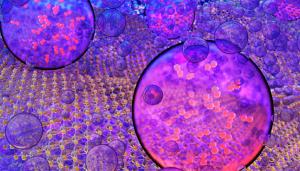LAB REPORT
Science and Technology Making Headlines
Jan. 30, 2015


New laser-driven shock compression experiments on a high-density form of silica reveal the unusual properties of rocks deep inside large exoplanets and giant planets. Photo by E. Kowaluk, LLE
Shedding light on alien planets
Lawrence Livermore scientists have re-created planet formation, super-Earths and giant planets in a laboratory setting.
The laser-driven compression experiments at the National Ignition Facility reproduced the conditions deep inside exotic super-Earths and giant planet cores, and the conditions during the violent birth of Earth-like planets, documenting the material properties that determined planet formation and evolution processes.
The team discovered the unusual properties of silica — a key component of rock — and other core metals at the center of planets under the extreme pressures and temperatures relevant to planetary formation and interior evolution.
“Our research suggests that silica is likely solid inside Neptune, Uranus, Saturn and Jupiter cores, which sets new constraints on future improved models for the structure and evolution of these planets,” LLNL physicist Marius Millot said.

Twin brothers, Jackie and Eric Berry, explain what they have learned in cybersecurity classes at Lowcountry Tech Academy, part of the Charleston County School District, which is the only K-12 school district participating in a five-year federal grant to help promote computer science and cybersecurity to students.
A pipeline for the cyber workforce
Lawrence Livermore will participate as a partner in a Cybersecurity Workforce Pipeline Consortium to help solve pressing and challenging cybersecurity problems.
Cybersecurity programs offered at Charleston County schools are poised to receive an infusion of resources through the consortium. The consortium is part of a five-year $25 million grant from the Department of Energy to grow cybersecurity programs at 13 historically black colleges and universities from five states, including seven institutions in South Carolina.
Tony Baylis, director of the office of strategic diversity and inclusion programs at Lawrence Livermore, said the idea behind targeting minority students is part of a larger goal to grow and diversify the talent pool for the cybersecurity workforce. “It’s kind of a natural fit,” he said.

Cantona was one of the largest cities in pre-Columbian Mesoamerica, with a population of 90,000 inhabitants at its peak. Scientists believe climate change was part of the reason the city was eventually abandoned.
Temperature rise, population falls
Lawrence Livermore scientist Susan Zimmerman and colleagues reconstructed the past climate for the region around Cantona, a large fortified city in highland Mexico, and found the population drastically declined in the past, at least in part because of climate change.
Cantona was one of the largest cities in pre-Columbian Mesoamerica, with a population of 90,000 inhabitants at its peak.
The team analyzed pollen, stable isotopes and elemental concentrations, which serve as proxies of past climatic and environmental conditions, from lake sediments in the region and found evidence of a regional drought between 500 and 1150 AD, about the same time Cantona was abandoned.
“Our research highlights the interplay of environmental and political factors in past human responses to climate change,” Zimmerman said.


LLNL-developed laser peening is one technology that successfully transferred to Metal Improvement Company, which is using it to strengthen aircraft engines, power turbines and other critical components of military and civilian systems.
From the lab to the world
The UC Davis Graduate School of Management will work with scientists and engineers at Lawrence Livermore and Sandia to help move innovation from the laboratory to the business world.
UC Davis, the two labs and the Livermore-based i-GATE Innovation Hub group won a $350,000 grant from the Department of Energy's Energy Efficiency and Renewable Energy office to launch the pilot program to be called Lab-Corps.
The Lab-Corps pilot program will create a competition in March that will grant $75,000 each to two teams of researchers from Livermore or Sandia to work on commercializing technology.


The Catalyst supercomputer at Lawrence Livermore is being used to rapidly detect and characterize pathogenic organisms such as viruses, bacteria or fungi in a biological sample.
Pathogens can’t hide from computers
In the realm of pathogenic threats, besides the usual suspects — anthrax, botulism, tuberculosis — there is a host of bacterial and viral pathogenic microbes that can be problematic to human and animal health.
Scientists are beginning to unlock the secrets of the microbial world thanks to powerful sequencing technology and advanced computing tools. Metagenomics helps scientists detect and characterize potentially dangerous pathogens and assess the threat potential of the organisms for human health.
Lawrence Livermore researchers are on the cusp of a breakthrough that would bring this problem down to size at a range of scales. Led by bioinformatics scientist Jonathan Allen, the team developed a novel approach to metagenomic sequencing using flash drives as a supplemental memory source to more efficiently search very large datasets.





